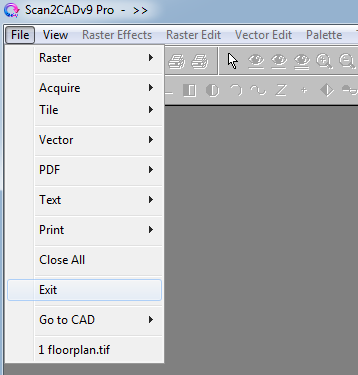Today we are extremely excited to announce the release of Scan2CAD v9, our most powerful release to-date.
This is a major update of Scan2CAD which sees a large number of enhancements and new features.
All of the developments in v9 were driven by you, the Scan2CAD community of users. We have you all to thank for helping us create something we are truly proud of. We hope you love it!
If you are already a Scan2CAD user, you can see details on how to upgrade to v9 here. And as usual, you can try Scan2CAD v9 for free here.
Getting straight into the details, here is an overview of what’s new in v9. Furthermore you can read a full, detailed list of updates in the spoiler at the end of this post.
A Brief Overview: What’s new in v9
- The extensive facilities already available in Scan2CAD for handling PDF files as detailed in the ‘22 Reasons To Choose Scan2CAD For PDF To CAD‘ have been further added to with:-
- Dash Lines: Where a dash line has been saved as a series of short broken lines and not saved as a user defined type, it is now possible for Scan2CAD to identify and rebuild these as a single dash, dash-dot and dot line types.
- Arrow Lines: Arrow lines (termed arrow leader lines in AutoCAD) are saved as a mixture of vectors lines and possibly solid polygons. It is now possible for Scan2CAD to identify and rebuild these as a single arrow leader line types.
- Masking Rectangles: PDF files commonly use masking rectangles to define areas on the printed document. These masking rectangles are normally encoded as solid white rectangles in the PDF file but when loaded into Scan2CAD and exported may result in non-required black rectangles. The user can now select whether to included or exclude these masking rectangles.
- PDF files can be generated from a myriad number of sources. Graphics packages may use the less common PolyBezier and PolyPolygon object vector types. These object types are now fully supported for editing and exporting. Where these object types are solid and the user requires their outlines only (typical CNC requirement) then they can readily be converted as required.
Supported File Types
Scan2CAD supports many vector export file types such DXF, SVG, HPGL, EMF, WMF.
- DWG: Our DXF files in particular have proved themselves to be highly transportable and capable of being loaded into virtually any CAD or CNC product without problems
Users have however pointed out that DXF files can be significantly larger then their equivalent DWG file types. Scan2CAD can now both load and save DWG files. So that these DWG files will load without problems into any CAD/CNC package, the user can also specify what version DWG file is required to match their current CAD package.
- CNC: Our DXF files have proved to be universally suitable for CNC systems however many users have requested the facility for exporting vectors from Scan2CAD in a G-Code compatible format. Scan2CAD can now do this allowing the user to export as G-Code format with a recognized CNC file type extension.
CNC Users
To provide full flexibility when exporting to a CNC G-Code format file, Scan2CAD provides a new CNC Export dialog where various options can be set for the file being exported.
Editing
Scan2CAD currently incorporates a simple to use but powerful set of drawing tools that operate in the same way whether in raster or vector mode.
This commonality and simplicity of use is now powerfully incorporated in the new Select tool which can be used in either raster or vector mode. For example, when in vector mode the user can select a grouping of vectors using rectangular or irregular polygon shape boundaries or individually by simply clicking on the vector. Selected vectors can be cut, copied, moved, pasted, rotated or scaled. Selected vector properties can also be changed.
Vectorization
Raster vectorization improvements have been made in the quality of line and edge following allowing better Bezier curve identification together with improved identification of Arrow line types.
More to come!
We release regular updates with new features and improvements in performance.


 About this table: The ‘Menu’ column refers to the specific Menu location where the feature resides. For example if the feature is within the ‘File’ menu, it would be in the location shown in the image to the right.
About this table: The ‘Menu’ column refers to the specific Menu location where the feature resides. For example if the feature is within the ‘File’ menu, it would be in the location shown in the image to the right.